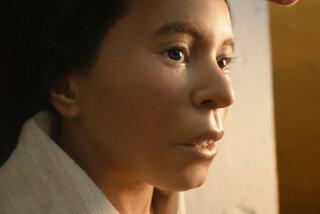Discovery of Ancient Mayan Mural Excites Scientists
- Share via
WASHINGTON — Disappointed at not finding the stone monuments he sought, a tired researcher sat down in the jungle shade and accidentally discovered the oldest known intact wall painting of Maya mythology.
Archeologist William Saturno discovered the 4-foot-long mural, dating from about AD 100, during research at San Bartolo, a Maya ceremonial site in Guatemala.
“This painting is among the most important finds in Maya archeology in the last few decades. It opens a window into the mythological and courtly life of the ancient Maya during the pre-classic period,” said Saturno, a University of New Hampshire lecturer and research associate at Harvard University’s Peabody Museum of Archaeology and Ethnology.
The discovery, made last year, is reported in the April issue of National Geographic magazine.
Saturno had been looking for some carved stone monuments in the area and was exhausted after an unexpectedly long three-day trek through the jungle.
Seeking shade, he sat down in a trench dug by looters seeking goods in the old Maya site.
He aimed his flashlight into a looter’s tunnel.
“I started laughing. There was this Maya mural, a very rare thing. The looters had cleared off a section and left it. I felt like the luckiest man on the planet,” he said in a statement.
The mural is in an 80-foot-high pyramid in northern Guatemala. The site is now under guard to protect it from more looting. Research on the mural is funded by the National Geographic Society’s Committee for Research and Exploration.
The mural was confirmed as Maya by comparing it with other work by that civilization. The Maya pre-classic period dates from about 2000 BC to AD 250. No other early mural of comparable size or condition has been found, researchers said.
The only previously known paintings from this period are from Tikal, one of the largest Maya ceremonial and political centers discovered in Guatemala. National Geographic said the Tikal paintings are not nearly as extensive or as well-preserved as the newly discovered mural.
Despite years of looting at the site over the last decade, the ruins at San Bartolo were previously unknown to archeologists.
The site is being studied by a team led by Saturno, David Stuart of Peabody Museum and Hector Escobedo from Guatemala’s Universidad del Valle. A five-year project to excavate the site and conserve the art gets underway this year.
Neftali Gonzalez, a spokeswoman for the Guatemalan culture ministry, said protecting the site is a government priority, and the government will cooperate with investigations.
The site “is threatened by looters of Mayan archeological sites,” Gonzalez said. “The complex has suffered looting, digging has been found and that has caused partial damage,” though she said that occurred before the discovery of the murals in March 2001.
The visible portion of the mural shows a scene with at least nine portraits. All the people stand or kneel above a border of geometric designs. The scene is dominated by a standing male figure who strides toward the viewer’s left, looking back over his shoulder at two kneeling female figures behind him. Behind the women is evidence of at least three other standing figures.
More to Read
Sign up for Essential California
The most important California stories and recommendations in your inbox every morning.
You may occasionally receive promotional content from the Los Angeles Times.













